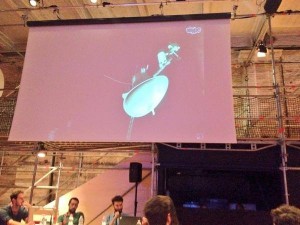Networked Public Space {Discussion on Venice Arch Biennial – 2014}
I participated on a discussion about the ‘Networked Public Space’, in the context of the ‘Networked Politics’ weekend special at the Architecture Venice Biennial. The NetPol weekend special, in the words of their organizers, “creates a new confrontation between the concreteness of built space and the immateriality of its operational boundaries. It also intends to challenge the dichotomy between virtual and physical networked communication, between individual and public space, between urbanity and domestic sphere“. The weekend special was coordinated dpr-barcelona (Ethel Baraona Pohl, César Reyes), FOLDER (Marco Ferrari, Elisa Pasqual), MAIO (Anna Puigjaner, Guillermo López) and Space Caviar (Joseph Grima, Tamar Shafrir, Simome C. Niquille).
The discussion took place the 6th of September of 2014, and the panel was also composed by Parasite 2.0 Lab, Silvio Lorusso and Tamar Shafrir, and moderated by César Reyes Nájera (dpr-Barcelona). During the discussion, theFOMO (an algorithmic publishing machine) was printing in real time the tweets and feed derived from the topics spoken in the panel. The artists Helson & Jackets also participated via Skype on the conversation, with their project help me obi, which ‘transports’ people in real-time Skype conversation to their interlocutors place via a hologram.
Despite the heterogeneous group of people and practices composing the panel, the discussion and conversation gave interesting insights in the changing role of the public space and the role of architecture (and design) within this change. The participation of Silvio Lorusso, who presented his ongoing PhD research project (P-DPA), gave interesting insights on the role of (new) media on the construction of public space, whilst the participation of Parasite 2.0 Lab challenged the traditional notions of architectural practice in public space. Myself, I intended to bring two concepts into consideration for the debate about (networked) public space: that of heterotopia (Foucault) and that of agonism (Mouffe). The need to build an “agonistic public sphere of contestation“ (Mouffe, 2005) resonates with considering a diversity of visions on the construction of (public) space, specially in today’s networked society:“heterotopia embodies the tension between place and non-place that today reshapes the nature of public space” (Michiel Dehaene & Lieven de Cauter, 2008). Perhaps the best way of achieving this is by reconsidering architecture and design practices (Parasite 2.0 Lab and myself), as well as applying new media and publishing (Silvio, Helson & Jackets and FOMO) while doing so.

An important reflection was triggered by a comment of Eugenio Cosentino (ParasiteLab), when he said that “today it was difficult to speak about ‘public space’, given the neoliberal logic that our cities are built by”. Now, even though it might be true that our cities are now planned and built following certain principles that go against the idea of the ‘public’, perhaps we have to drift away the look from the physicality of the space, to the agency of the human beings in it. In other words, there has never really existed a public space, but there has always existed space and it depended on us (humans, not designers) to make it public, and tools as publishing and new media might help us in doing so.
